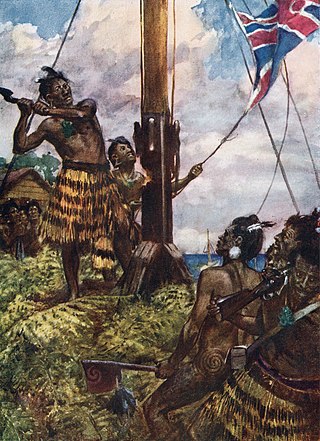
The Flagstaff War, also known as Heke's War, Hōne Heke's Rebellion and the Northern War, was fought between 11 March 1845 and 11 January 1846 in and around the Bay of Islands, New Zealand. The conflict is best remembered for the actions of Hōne Heke who challenged the authority of the British by cutting down the flagstaff on Flagstaff Hill at Kororāreka. The flagstaff had been a gift from Hōne Heke to James Busby, the first British Resident. The Northern War involved many major actions, including the Battle of Kororāreka on 11 March 1845, the Battle of Puketutu on 8 May 1845, the Battle of Ōhaeawai on 23 June 1845 and the siege of Ruapekapeka Pā from 27 December 1845 to 11 January 1846.

Russell, also known by the Māori name Kororāreka, is a town in the Bay of Islands, in New Zealand's far north. It was the first permanent European settlement and seaport in New Zealand.

The Northland Region is the northernmost of New Zealand's 16 local government regions. New Zealanders sometimes refer to it as the Winterless North because of its mild climate all throughout the year. The major population centre is the city of Whangārei, and the largest town is Kerikeri. At the 2018 New Zealand census, Northland recorded a population growth spurt of 18.1% since the previous 2013 census, placing it as the fastest growing region in New Zealand, ahead of other strong growth regions such as the Bay of Plenty Region and Waikato.
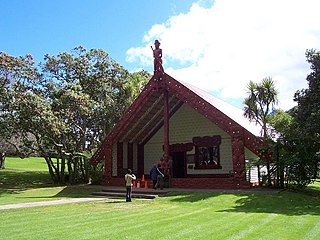
Waitangi is a locality on the north side of the Waitangi River in the Bay of Islands, 60 kilometres north of Whangārei, on the North Island of New Zealand. It is close to the town of Paihia, to which it is connected by a bridge near the mouth of the Waitangi River estuary. While Statistics New Zealand and NZ Post consider the southern boundary of Waitangi to be the river and estuary, with the area further south being part of Paihia, the area by Te Tī Bay, immediately south of the river, is sometimes referred to as part of Waitangi.

Ngāpuhi is a Māori iwi associated with the Northland regions of New Zealand centred in the Hokianga, the Bay of Islands, and Whangārei.

Paihia is the main tourist town in the Bay of Islands in the Northland Region of the North Island of New Zealand. It is 60 kilometres north of Whangārei, located close to the historic towns of Russell and Kerikeri. Missionary Henry Williams named the mission station Marsden's Vale. Paihia eventually became the accepted name of the settlement.

Okiato or Old Russell is a small town in the Bay of Islands, New Zealand, 7 kilometres (4.3 mi) south of present-day Russell. It was founded in 1840 and served as New Zealand's first national capital until 1841, when the seat of government was moved to Auckland. The car ferry across the Bay of Islands, which provides the main access to Russell, runs between Okiato and Opua.

Far North District Council is the territorial authority for the Far North District of New Zealand.
MokaKainga-mataa [Te Kaingamataa/Te Kaingamata/Te Kainga-mata/Te Kainga-mataa] (1790s–1860s) was a Māori rangatira (chief) of the Ngā Puhi iwi from Northland in New Zealand. He was distinguished in war and an intelligent participant in the Treaty of Waitangi process.
The Hapu Party was a Māori political party in New Zealand that was formed in August 2008 and contested the Te Tai Tokerau seat in the 2008 general election. The party was led by David Rankin, a leader of the Matarahurahu hapū of Northland.
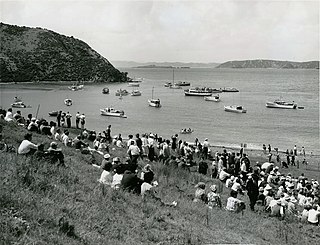
Rangihoua Bay is a bay at the southern end of the Purerua Peninsula, on the north-west shore of the Bay of Islands in Northland, New Zealand. It is 10 km north across the Bay of Islands from Russell and 12 km north from Paihia. By road it is 32 km from Kerikeri.
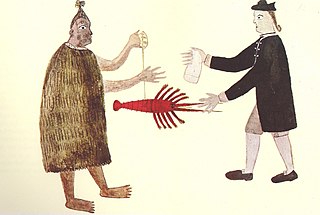
Wellington has been the capital of New Zealand since 1865. New Zealand's first capital city was Old Russell (Okiato) in 1840–41. Auckland was the second capital from 1841 until 1865, when Parliament was permanently moved to Wellington after an argument that persisted for a decade. As the members of parliament could not agree on the location of a more central capital, Wellington was decided on by three Australian commissioners.
Urupukapuka Island is the largest island in the Bay of Islands of New Zealand, located about 7.3 km (4.5 mi) from Paihia. The island is a popular stopover point for tour boats to the Hole in the Rock and is also serviced by ferries for day trips from Paihia and Russell.
The Girls’ War is the name given to fighting on the beach at Russell, New Zealand, then known as Kororāreka, in March 1830 between the northern and southern hapū (subtribe) within the Ngāpuhi iwi (tribe).

Edward Marsh Williams was a missionary, interpreter, and judge who played a significant role in the British colonisation of New Zealand. He was born in Hampstead, Middlesex, the eldest son of Archdeacon Henry Williams and Marianne Williams.
The New Zealand Church Missionary Society (NZCMS) is a mission society working within the Anglican Communion and Protestant, Evangelical Anglicanism. The parent organisation was founded in England in 1799. The Church Missionary Society (CMS) sent missionaries to settle in New Zealand. The Rev. Samuel Marsden, the Society's Agent and the Senior Chaplain to the New South Wales government, officiated at its first service on Christmas Day in 1814, at Oihi Bay in the Bay of Islands, New Zealand.

Christ Church is New Zealand's oldest surviving church, located in the village of Russell.

Pōmare II, originally named Whiria, was a Māori rangatira (chief) of the Ngāpuhi iwi (tribe) in New Zealand and the leader of the Ngāti Manu hapū (subtribe) of the Ngāpuhi. He was the nephew of Pōmare I, his mother Haki being the elder sister of Pōmare I. When he succeeded his uncle as leader of the Ngāti Manu he took his uncle's names, Whētoi and Pōmare. He is referred to as Pōmare II, so as to distinguish him from his uncle.
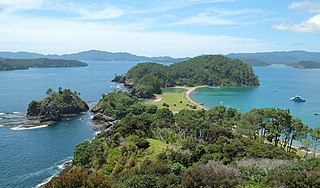
Motuarohia Island is a small island in the Bay of Islands of New Zealand, located about 4 kilometres (2.5 mi) northeast of Russell. The island stretches for 2 kilometres (1.2 mi) east-west, with the south coast offering two bays backed by sandy beaches. The north coast is dominated by steep cliffs in the west, rising to 78 metres (256 ft), and two shallow lagoons in the west. The twin lagoons nearly reach across the island to the bay on the south coast, almost bisecting the island.
Puketona is a locality at the junction of State Highway 10 and State Highway 11 in the Far North District of New Zealand. Kerikeri is 10 kilometres north, Paihia is 14 kilometres east, Moerewa is 15 kilometres southeast, and Kaikohe is 20 kilometres southwest.

















